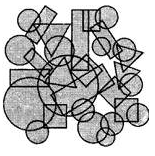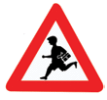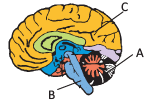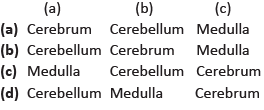Science Olympiad Model Test Paper - 1 | Science Olympiad Class 4 PDF Download
Note: The questions provided in this document are similar to the questions that were asked in the actual Olympiad exam. So, we recommend you study these for your Olympiad preparation.
Logical Reasoning Section
Q1: If all the symbols are removed from the given arrangement, then how many elements will be left?
S # A 1 P @ R ! 4 T U $ K O 5 L N * H 8
(a) 16
(b) 14
(c) 15
(d) 18
 View Answer
View Answer 
Ans: (c)
- To find out how many elements remain after removing the symbols, we first identify the letters and numbers in the arrangement.
- The given arrangement is: S # A 1 P @ R ! 4 T U $ K O 5 L N * H 8.
- Counting the letters (S, A, P, R, T, U, K, O, L, N, H) gives us 11 letters.
- Counting the numbers (1, 4, 5, 8) gives us 4 numbers.
- So, the total number of elements left after removing symbols is 11 letters + 4 numbers = 15 elements.
Q2: How many circles are there in the given figure? 
(a) 10
(b) 11
(c) 15
(d) 13
 View Answer
View Answer 
Ans: (c)
There are 15 circles in the given figure.
Q3: Identify the word that cannot be created using the letters from the word: CHOCOLATE
(a) CATCH
(b) CLOTH
(c) CHEAT
(d) CLASH
 View Answer
View Answer 
Ans: (d)
- The word CHOCOLATE contains the letters: C, H, O, L, A, T, E.
- CATCH can be formed using C, A, T, and H.
- CLOTH can be formed using C, L, O, T, and H.
- CHEAT can be formed using C, H, E, A, and T.
- However, CLASH requires an S, which is not present in the letters of CHOCOLATE.
Q4: Arrange the following words according to dictionary arrangement
1. Epitaxy
2. Episode
3. Epigene
4. Epitome
5. Epilogue
(a) 1, 2, 3, 4, 5
(b) 3, 2, 5, 4, 1
(c) 3, 5, 2, 1, 4
(d) 5, 4, 2, 1, 3
 View Answer
View Answer 
Ans: (b)
Dictionary arrangement of words is as follows Epigene, Epilogue, Episode, Epitaxy, Epitome i.e., 3, 5, 2, 1, 4
Q5: Some letters are given which are numbered 1, 2, 3, 4, 5 and 6 followed by four options containing combinations of these numbers. Find the combination of numbers so that letters arranged accordingly form a meaningful word.
L U Z P E Z 1 2 3 4 5 6
(a) 4, 3, 5, 6, 1, 2
(b) 4, 3, 2, 1, 5, 6
(c) 4, 2, 3, 1, 6, 5
(d) 4, 2, 3, 6, 1, 5
 View Answer
View Answer 
Ans: (d)
Meaningful word is P U Z Z L E 4 2 3 6 1 5
Science Section
Q6: The set of organs performing a specific activity is called a/an
(a) organism
(b) organ structure
(c) organ system
(d) tissue
 View Answer
View Answer 
Ans: (c)
Some important organ systems are digestive, respiratory, circulatory, skeletal and nervous.
Q7: The _________________system defines the structure of the body.
(a) skeletal
(b) nervous
(c) respiratory
(d) digestive
 View Answer
View Answer 
Ans: (a)
The bones (part of skeletal system) help in defining the structure of the body.
Q8: Kirti has removed all the leaves from a plant. What will occur to the plant after a week?
(a) The plant will perish.
(b) The plant will accumulate additional food.
(c) The roots will take in more water and mineral nutrients.
(d) The plant will absorb a greater amount of carbon dioxide.
 View Answer
View Answer 
Ans: (a)
- The plant relies on its leaves for photosynthesis, which is the process of converting sunlight into energy.
- Without leaves, the plant cannot produce food, leading to a lack of energy.
- Over time, this will cause the plant to weaken and eventually die due to starvation.
- In summary, the absence of leaves means the plant cannot sustain itself, resulting in its demise.
Q9: The given picture shows the process of __________.
 (a) Freezing
(a) Freezing
(b) Melting
(c) Evaporation
(d) Condensation
 View Answer
View Answer 
Ans: (b)
- Melting is the process where a solid turns into a liquid when it is heated.
- In this case, the picture likely depicts a solid substance that is changing into a liquid form.
- This is different from freezing, which is the opposite process, where a liquid becomes a solid.
- Evaporation involves a liquid turning into a gas, while condensation is when a gas turns back into a liquid.
Q10: The skeletal system shows how the __________ of the body are connected.
(a) bones
(b) nerves
(c) blood cells
(d) organs
 View Answer
View Answer 
Ans: (a)
The skeletal system is made up of all the bones inside our body.
Q11: Ritika is looking to purchase fruits to prepare a fruit salad. She should visit a __________.
(a) Baker
(b) Mason
(c) Chemist
(d) Greengrocer
 View Answer
View Answer 
Ans: (d)
- To make a fruit salad, fresh fruits are essential.
- A greengrocer specializes in selling fruits and vegetables, making it the best choice.
- Other options like a baker focus on bread, a mason works with stone, and a chemist sells medicines.
- Thus, the most suitable place for Ritika to buy fruits is the greengrocer.
Q12: Why do we choose to wear white or light-colored clothing during the summer?
(a) These clothes reflect the heat and keep the body cool.
(b) These clothes absorb the heat and keep the body cool.
(c) These clothes absorb the heat and keep the body warm.
(d) These clothes reflect the heat and keep the body warm.
 View Answer
View Answer 
Ans: (a)
- Light-colored clothing is preferred in summer because it reflects sunlight, which helps to keep the body cool.
- In contrast, dark colors tend to absorb heat, making you feel warmer.
- Wearing white or light colors is a simple way to stay comfortable in hot weather.
- This choice is based on the basic principle of how colors interact with light and heat.
Q13: What is the other name of the skull bone?
(a) Medulla
(b) Cranium
(c) Cerebrum
(d) Cerebellum
 View Answer
View Answer 
Ans: (b)
It acts as a protective cover for the brain.
Q14: Who among the following was NOT a member of the Apollo 11 crew?
(a) Neil Armstrong
(b) Kalpana Chawla
(c) Edwin Aldrin
(d) Michael Collins
 View Answer
View Answer 
Ans: (b)
- Apollo 11 was the first mission to land humans on the Moon, and its crew included Neil Armstrong, Edwin Aldrin, and Michael Collins.
- Kalpana Chawla was an astronaut, but she was not part of the Apollo 11 mission; she flew on different space missions later.
- The mission took place in 1969, and Armstrong famously became the first person to walk on the Moon.
- Understanding the crew members is essential to grasping the history of space exploration.
Q15: Select the INCORRECT statement:
(a) See-saw is an example of a lever.
(b) A screw is a simple machine that has a grooved wheel and a belt running in the groove of the wheel.
(c) A person standing on a road with a heavy load on his head is not doing any work.
(d) Wedge is made up of two inclined planes.
 View Answer
View Answer 
Ans: (b)
- The statement about a screw is incorrect because a screw is not defined by a grooved wheel and rope; instead, it is a simple machine that converts rotational motion into linear motion.
- A see-saw is indeed a lever, which is a type of simple machine that helps lift loads.
- The person with a heavy load is not doing work in the physics sense, as work requires movement in the direction of the force applied.
- A wedge is correctly described as being made up of two inclined planes, which helps in splitting or cutting objects.
Q16: Which of the following birds constructs a cup-shaped nest in bushes?
(a) Bulbul
(b) Penguin
(c) Weaver bird
(d) Sparrow
 View Answer
View Answer 
Ans: (a)
- Bulbuls are known for their unique nesting habits, particularly their ability to create a cup-shaped nest in bushes.
- Unlike penguins, which do not build traditional nests, bulbuls prefer dense foliage for protection.
- Weaver birds create intricate woven nests, while woodpeckers typically excavate holes in trees.
- Thus, the correct answer is the bulbul, as it is specifically known for this type of nesting behavior.
Q17: The bones forming the skeletal are grouped _______________________.
(a) jointly
(b) separately
(c) together
(d) away
 View Answer
View Answer 
Ans: (c)
The combination of various bones together makes one major bone structure like skull, rib cage, backbone, etc.
Q18: There are more than ___________ bones in the body when a human being is born?
(a) 100
(b) 200
(c) 300
(d) 450
 View Answer
View Answer 
Ans: (c)
These later on fuse to form 206 bones in an adult human being.
Q19: Which of the following statements regarding fish is/are accurate?
(i) They have scales to protect their body.
(ii) They reproduce by laying many eggs at a time.
(iii) They have gills which help them to swim faster.
(a) (i) and (ii) only
(b) (ii) and (iii) only
(c) (ii) only
(d) (iii) only
 View Answer
View Answer 
Ans: (a)
- Fish have scales that serve to protect their bodies, which is true.
- They typically reproduce by laying many eggs at once, making statement (ii) correct.
- However, statement (iii) is incorrect because gills are used for breathing underwater, not for swimming faster.
- Thus, the correct options are (i) and (ii) only, leading to the answer (a).
Q20: Important organs like heart and lungs are inside the hole of
(a) skull
(b) rib cage
(c) back bone
(d) pelvic girdle
 View Answer
View Answer 
Ans: (b)
It forms the chest of the skeletal.
Q21: The bones of elbow and knee joints move in ____________.
(a) One direction
(b) All directions
(c) Two directions
(d) Four directions
 View Answer
View Answer 
Ans: (a)
Elbow and knee joints moves only in one direction.
Q22: How do teeth assist in the digestion process?
(a) They create the digestive fluid known as saliva.
(b) They generate acid to eliminate bacteria in food.
(c) They aid in cutting, chewing, and grinding food into smaller pieces.
(d) They help to shape food particles into balls for easier swallowing.
 View Answer
View Answer 
Ans: (c)
- Teeth play a crucial role in digestion by mechanically breaking down food.
- They cut, chew, and grind food into smaller pieces, making it easier for the stomach to digest.
- While saliva is important, it is produced by glands, not teeth.
- Teeth do not produce acid or roll food into balls; their main function is to prepare food for swallowing.
Q23: Which of the following diseases is caused by a protozoan?
(a) Sleeping sickness
(b) Influenza
(c) Tuberculosis
(d) Ringworm
 View Answer
View Answer 
Ans: (a)
- Sleeping sickness is caused by a protozoan parasite called Trypanosoma, transmitted by tsetse flies.
- In contrast, Dengue is caused by a virus, Tuberculosis is caused by bacteria, and Ringworm is a fungal infection.
- Protozoans are single-celled organisms, and they can lead to various diseases in humans.
- Understanding the type of organism responsible for a disease helps in determining the appropriate treatment.
Q24: The animals has hind limb longer than the forelimbs is:
(a) Frog
(b) Chimpanzee
(c) Elephant
(d) Goat
 View Answer
View Answer 
Ans: (a)
In frog hind limb is longer than forelimbs.
Q25: Rohit was driving his car. Suddenly, he saw a road sign as shown in the given picture. What should he do? (a) Speed up his car
(a) Speed up his car
(b) Start honking
(c) Slow down the speed of his car
(d) Make a U-turn
 View Answer
View Answer 
Ans: (c)
- Slow down the speed of his car is the correct action when encountering a road sign that likely indicates a need for caution.
- Road signs are there to provide important information about the road conditions ahead.
- By slowing down, Rohit can ensure his safety and the safety of others on the road.
- Speeding up or honking would not be appropriate responses to a warning sign.
Q26: How many main types of nerves are there in the human body?
(a) 2
(b) 5
(c) 7
(d) 9
 View Answer
View Answer 
Ans: (a)
These are motor nerves and sensory nerves.
Q27: Which of these form arms and legs of the skeletal?
(a) rib cage
(b) pelvic
(c) skull
(d) None of these
 View Answer
View Answer 
Ans: (d)
The arms and legs of the skeletal are formed by the limbs.
Q28: The spinal cord is protected by the ________________.
(a) skull
(b) pelvic girdle
(c) back bone
(d) rib cage
 View Answer
View Answer 
Ans: (c)
The spinal cord fits inside the cavities in the backbone.
Q29: ________________ is the long central bone of the rib cage.
(a) Sternum
(b) Femur
(c) Tarsals
(d) Cranium
 View Answer
View Answer 
Ans: (a)
It is the vertical bone that joins all the curved bones of the rib cage. It provides the strength to the rib cage.
Q30: Fill in the blank.
Sense organs → ___________ → Brain
(a) Sensory Nerves
(b) Neuron Nerves
(c) Motor Nerves
(d) Any of these
 View Answer
View Answer 
Ans: (a)
Sensory nerves make the brain aware about the sight, smell, touch, hearing and taste senses.
Achiever’s Section
Q31: Identify which of these statements are true or false and choose the correct option.
(i) There are 206 bones in an adult human being.
(ii) Spinal cord has more neurons than the brain.
(iii) Backbone is also called the ‘second brain’.
(iv) The jaw is the part of the skull.
(a) TTFF
(b) FFTT
(c) FTFT
(d) TFFT
 View Answer
View Answer 
Ans: (d)
Brain has more neurons than spinal cord. Spinal cord is also called the ‘second brain’.
Q32: Identify the correct labelling of the parts of brain.


 View Answer
View Answer 
Ans: (d)
The three main parts of the brain can be arranged in the order as of the given figure as Medulla, Cerebellum and Cerebrum.
Q33: The three parts of the spinal cord can be arranged from bottom to top as
(a) Cervical, Thoracic, Lumbar
(b) Lumbar, Thoracic, Cervical
(c) Cervical, Lumbar, Thoracic
(d) Thoracic, Lumbar, Cervical
 View Answer
View Answer 
Ans: (b)
Cervical is present in the neck, Thoracic in the upper back and lumbar in the lower back.
Q34: Which of the following statements are NOT TRUE?
(i) Jupiter takes around 12 years to orbit around the Sun.
(ii) Mars has no moon.
(iii) Saturn has the longest revolution period in the Solar System.
(a) (i) and (iv) only
(b) (ii) and (iv) only
(c) (ii) and (iii) only
(d) (i) and (ii) only
 View Answer
View Answer 
Ans: (c)
- The question asks for statements that are incorrect about planets.
- Statement (i) is correct; Jupiter does take about 12 years to orbit the Sun.
- Statement (ii) is incorrect; Mars actually has two small moons, Phobos and Deimos.
- Statement (iii) is correct; Saturn does have a long revolution period, but it is not the longest; that title goes to Neptune.
- Statement (iv) is correct; Venus does rotate from East to West, which is opposite to most planets.
- Thus, the incorrect statements are (ii) and (iii), making option (c) the right choice.
Q35: The tarsals are present in the __________.
(a) wrists
(b) ankles
(c) angles
(d) twists
 View Answer
View Answer 
Ans: (b)
The tarsals connect the feet to the skeletal.
|
52 videos|70 docs|53 tests
|
FAQs on Science Olympiad Model Test Paper - 1 - Science Olympiad Class 4
| 1. What topics are covered in the Achiever’s Section of the Science Olympiad Model Test Paper - 1 for Class 4? |  |
| 2. How can students prepare effectively for the Logical Reasoning Section of the Science Olympiad? |  |
| 3. What is the importance of participating in the Science Olympiad for Class 4 students? |  |
| 4. Are there any specific study materials recommended for Class 4 Science Olympiad preparation? |  |
| 5. What is the format of the Science Olympiad Model Test Paper - 1 for Class 4? |  |
















